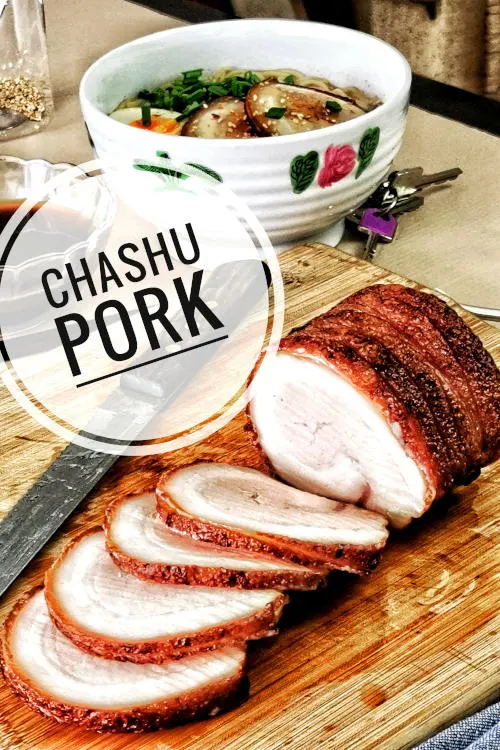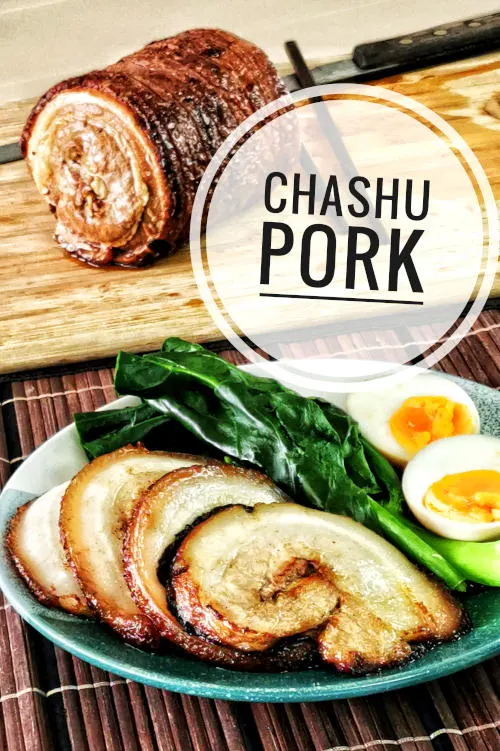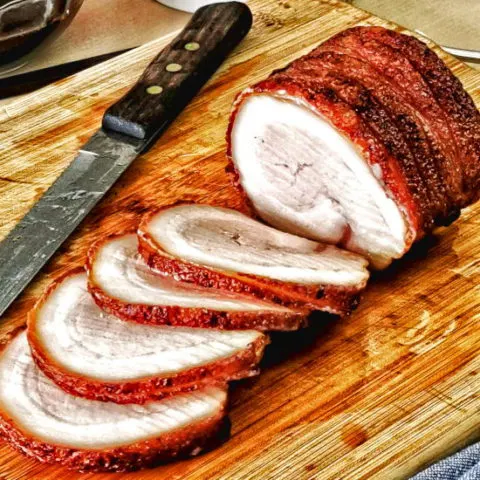Although Japanese chashu pork is known to most people as the favorite topping for ramen, it is the melt in the mouth texture and the aesthetic appearance that capture people’s hearts.
Can you make it at home? Certainly. Here is the breakdown of preparing homemade chashu, with a video explanation.
What is chashu? Although this chashu (also called cha shu/ 焼豚) means grilled or fried pork, the cooking starts with braising the pork. Therefore, the outcome is different from the Chinese Char Siu, which is barbecued all the way.
Let’s dive into the details.
Note: This post may contain affiliate links. Please read my privacy policy for more info. I may receive commissions for purchases made through links in this post. As an Amazon Associate, I earn from qualifying purchases.

How to prepare chashu pork
You can prepare the chashu pork either in the rolled or non-rolled form. I will prepare the rolled pork belly chashu in this recipe, more commonly served as ramen toppings.
The purpose of rolling up the pork is to keep the meat moist during the cooking process and to have a better appearance.
I prefer using pork belly for making chashu because it has a higher fat content and therefore has a melt in your mouth texture. You can use pork shoulder or other leaner cuts, for example, pork loin. However, the meat tends to dry out in the process.
1. Roll and tie the pork belly
- After purchasing the pork belly block from the butcher, cut the sides to make it into a rectangle. The longer side of the slab of pork belly should have a length enough to roll it up to like a Swiss roll. The cut-off portions can be reserved for other dishes. The slab of pork belly in this chashu recipe is about 1kg.
- Remove the pork from the freezer in advance if it is frozen. The pork belly has to be at room temperature since you need to roll it up.
- First, roll the slab of pork belly into a log.
- Wrap around one end of the rolled pork twice with butcher’s twine. Apply some strength to tie a knob to secure it. Please remember you need to leave a few inches of twine at the end.
- Now pull the twine across the log to the other end of the pork roll. Wrap around the other end twice while applying some pressure. Now both ends are secured.
- Continue wrapping around the pork by working back to the starting point. Leave about 1cm / 0.5 inch between each wrap.
- When the twine is returning to the starting end, find the loose end of the twine and then tie two ends together and make a knot.
Note: You can refer to the video on this page about tying and rolling the chashu. It starts at 0.38 minutes.
Tips:
- You need to ensure the pork is rolled up in proper shape while securing it with the twine to have a perfect appearance.
- I leave the skin on, but you use skinless pork belly if you do not like it.
- Make sure you tie the pork tightly so that it will not open up after removing the twine.
2. Braise the pork belly with the seasonings and aromatics
Making pork chashu involves braising the pork belly in the seasoning, searing the outer skin, and serving as thin slices.
The seasonings
Here are the main seasoning ingredients:
Onion, ginger, and scallion (green onions) are the aromatics. They are also used in most Chinese braising dishes. Here is a Chinese soy sauce chicken recipe that involves braising for your comparison, which involves different spices apart from ginger and scallion.
Sake, mirin, and Japanese soy sauce are more specific to Japanese cooking. An equivalent for Chinese cuisine will be Shaoxing wine (or other rice wine) and Chinese light and dark soy sauce.
Kombu is optional, but it gives an added flavor. If you use kombu, remove it a few minutes after simmering, as prolonged boiling will extract other undesirable components from the kombu and become bitter.
Braise the chashu
- Place all the seasonings in a pot, Dutch oven or slow cooker.
- Place the pork belly into the pot, then add sufficient cold water to almost cover it.
- Bring the liquid to a boil, skim off the scum, and foam floating on top with a wire mesh strainer.
- Reduce the heat to low temperature and braise the pork belly for 90 minutes. Rotate the pork every thirty minutes to ensure it soaks up all the flavors and is evenly cooked.
- After ninety minutes, remove the chashu. Let it cool.
- Meanwhile, strain the braising liquid through a wire mesh strainer.
Tips
- You should choose a pot that is just nice to fit in the pork. You will need much more water to submerge the pork if you use an oversized pot. As a result, the water will dilute the flavor of the seasonings. Since the pot I used was big, I transferred the pork to a smaller pot to braise in the last thirty minutes when the water level dropped too much after evaporating.
- If you find difficulty to let the pork submerge fully in the liquid, you can place a otoshibuta (drop lid) on top. This way will ensure ensures that the chashu pork will absorb all the flavors evenly from the broth.

3. Sear the chashu
- Dap dry the chashu with a paper towel. This step reduces the splattering while searing the chashu in the next step.
- Heat some oil in a pan or cast iron skillet over medium to high heat.
- Place the pork in the pan, and let it sear on all sites until golden brown.
- The cooking time depends on how long it takes to reach golden, as we do not intend to cook the pork fully at this stage. Once it is done, remove and let it cools.
Note: Some cooks sear the pork first before braising. I sear it after braising, and it works either way.
4. Let’s keep the chashu overnight
- Place about 2 cups of the braising liquid in another pot and bring it to a boil again. Let it boil for ten minutes to cook down the liquid further. We will use this chashu sauce to soak the chashu.
- When the chashu sauce is cold, place the liquid and the seared chashu in a ziplock bag.
- Place it in the refrigerator to let the pork belly soak in the chashu sauce. Adjust the position of the pork occasionally to ensure every part is submerged in the liquid.
Note:
- I prefer using the cook-down braising liquid to soak the chashu since it has a stronger flavor.
5. Cut and pan-fry the chashu
On the next day, remove the chashu from the ziplock bag.
- Cut the kitchen twine with a pair of kitchen scissors.
- Cut the pork into slices with a serrated knife, about 1/4 inches thick.
- Heat a small amount of oil in a pan.
- Lightly brown both sides to bring out the flavor.
- Place the slices of chashu pork on top of tonkotsu ramen or any other dishes.
Note:
- You can replace the pan-fry step with a blow torch (those culinary used butane torch) to char the surface before serving.
- If you cannot finish eating all the chashu, freeze the extra portion of the chashu uncut in a freezer-safe container.
Make use of the remaining chashu sauce
You do not need to use all the braising liquid (i.e., the chashu sauce) to soak the pork overnight. The extra liquid is packed with flavor and can be used in other dishes.
Make some ramen eggs (ajitsuke tamago)
You can make some ramen eggs (those eggs with runny yolk served with ramen) with the sauce. The method is quite simple.
- Bring some water to a boil sufficient to submerge the eggs.
- Add a tablespoon of white vinegar. Vinegar makes the eggs easier to peel later.
- Place the chilled eggs (direct from the refrigerator) into the boiling water. Let them boil for seven minutes. Since the egg yolks are cold, the egg whites will be cooked, but the egg yolks at the center are still runny after boiling for seven minutes.
- Remove the eggs and place them in ice water to stop cooking immediately.
- Remove the shell and soak the eggs in the cleaned braising liquid left from the pork.
- Let the eggs chilled in the refrigerator to absorb the flavor, and serve cold.
Other usages
You can strain the braising liquid and keep it in the refrigerator for a month. Then, you can use this liquid to marinate any meat for grilling or as a stir-fry sauce for other dishes.
How to serve
The typical way to serve the sliced chashu is with ramen. Besides that, you can serve it in a rice bowl over steamed rice (chashu don) or use it to make chashu fried rice, which is an ideal way to use up the broken pieces after slicing the chashu.
Check out these related recipes
If you like this chashu recipe, chances are you may also like the following recipes. Check them out:
Miso soup is a warm and comforting Japanese soup prepared with a soup stock (Dashi) and miso paste. It is the soul food for the Japanese, which serve together with rice. Kombu is the main ingredient to make the soup stock, Dashi.
Soy sauce chicken is a famous Cantonese cuisine that is easy to prepare. The flavor is exceptional, using the top-quality premium soy sauce and braiser at a sub-boiling temperature. The braising method is quite similar to making chashu.

Chashu pork recipe- How to make Japanese ramen chashu pork
Although Chashu is known to most people as the favorite topping for ramen, it is the melt in the mouth texture and the aesthetic appearance that capture people’s hearts.
Can you make it at home? Certainly. Here is the breakdown of how to prepare homemade chashu.
Ingredients
- 1kg pork belly, skin on
- 1 medium-size onion, cut into quarter
- 10g kombu (optional)
- 2 stalks scallion, cut into 3-inch sections
- 4 tbsp sugar
- 4 tbsp sake
- 4 tbsp mirin
- 15g ginger, cut into thin slices
- 1 cup Japanese soy sauce
- Sufficient water to submerge the pork belly in the pot
Instructions
Tie and roll the pork
- Roll the slab of pork belly into a log.
- Wrap around one end of the rolled pork twice with kitchen twine. Please remember you need to leave a few inches of twine at the end.
- Now pull the twine across the log to the other end. Wrap around the other end twice while applying some pressure.
- Continue wrapping around the pork by working back to the starting point. Leave about 1cm / 0.5 inch between each wrap.
- When the twine is returning to the starting end, find the loose end of the twine and then tie two ends together and make a knot.
Braise the chashu
- Place all the ingredients in a pot.
- Bring the liquid to a boil, skim off the scum.
- Braise the pork belly over low heat for 90 minutes. Then, rotate the pork every thirty minutes.
- Remove the chashu. Let it cools.
- Strain the braising liquid through a wire mesh strainer.
Sear the chashu
- Dap dry the chashu with a paper towel. Sear on all sites until golden brown.
Keep the chashu overnight.
- Bring 2 cups of the braising liquid to a boil for ten minutes to cook down the liquid further. Place the liquid and the seared chashu in a ziplock bag. Refrigerate overnight.
Cut and pan-fry the chashu
- On the next day, remove the kitchen twine with a pair of kitchen scissors.
- Slice the chashu with a sharp bread knife into 1/4 inches pieces.
- Heat a small amount of oil in a pan. Lightly brown both sides to bring out the flavor.
- Serve with ramen or any other dishes.
Recommended Products
As an Amazon Associate and member of other affiliate programs, I earn from qualifying purchases.
-
 Kitchen Shears, iBayam 2-Pack Kitchen Scissors Heavy Duty Meat Scissors, Dishwasher Safe Cooking Scissors, Multipurpose Stainless Steel Sharp Utility Food Scissors for Chicken, Poultry, Fish, Herbs
Kitchen Shears, iBayam 2-Pack Kitchen Scissors Heavy Duty Meat Scissors, Dishwasher Safe Cooking Scissors, Multipurpose Stainless Steel Sharp Utility Food Scissors for Chicken, Poultry, Fish, Herbs -
 Regency Natural Cooking Twine 1/2 Cone 100% Cotton 500ft
Regency Natural Cooking Twine 1/2 Cone 100% Cotton 500ft -
 Kikkoman Manjo Aji Mirin, 17 fl oz
Kikkoman Manjo Aji Mirin, 17 fl oz -
 Kikkoman Ryorishi Cooking Sake Seasoning, 33.8-Ounce (Pack of 3)
Kikkoman Ryorishi Cooking Sake Seasoning, 33.8-Ounce (Pack of 3)
Nutrition Information:
Yield: 15 Serving Size: 1Amount Per Serving: Calories: 241Total Fat: 15gSaturated Fat: 5gTrans Fat: 0gUnsaturated Fat: 9gCholesterol: 58mgSodium: 1001mgCarbohydrates: 7gFiber: 0gSugar: 6gProtein: 17g
This data was provided and calculated by Nutritionix on 9/27/2021

Chris
Wednesday 4th of December 2024
Tried making the chashu for ramen and used extra sauce to make ramen eggs. Family loved both the chashu and eggs. Thanks
KP Kwan
Monday 27th of September 2021
Hi, this is KP Kwan. I am happy to see you in this comment area, as you have read through my recipe. I am glad to reply to any questions and comments as soon as possible.